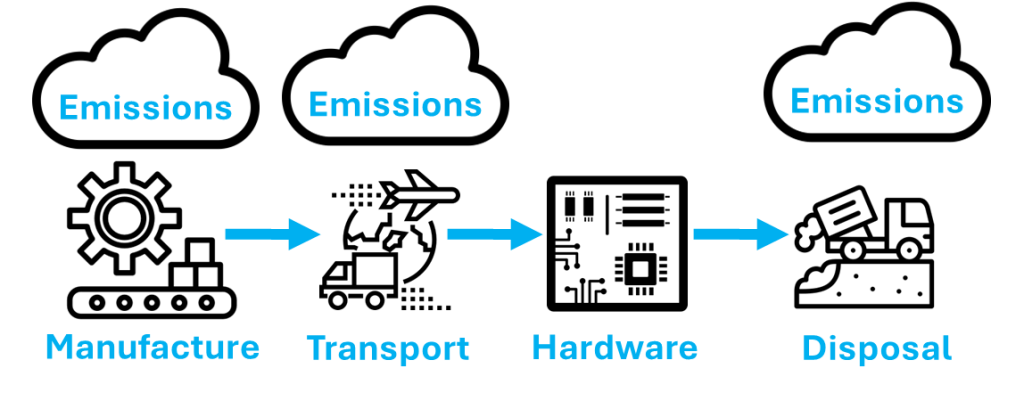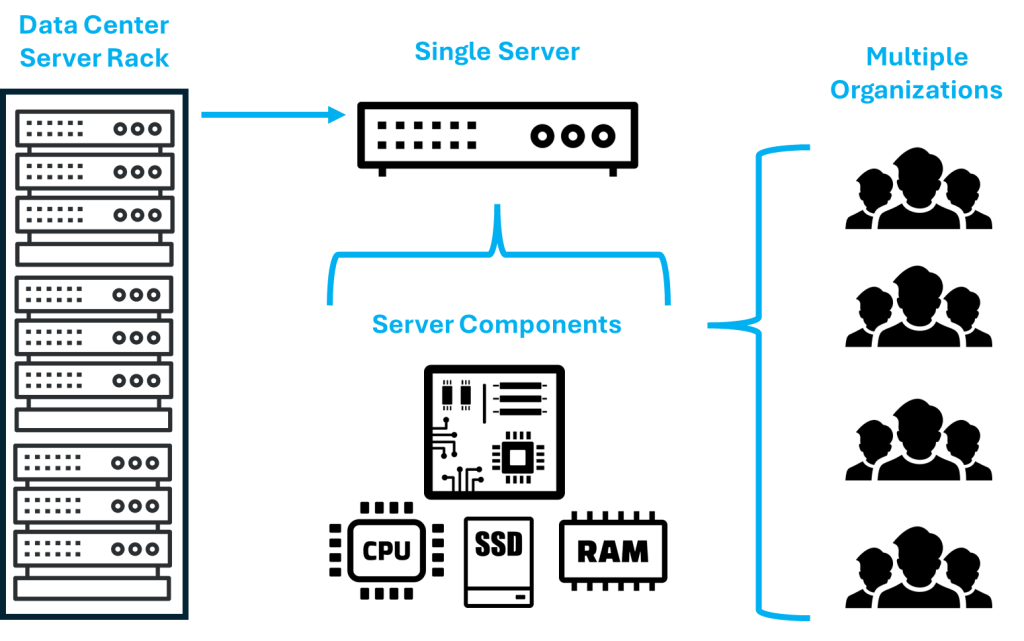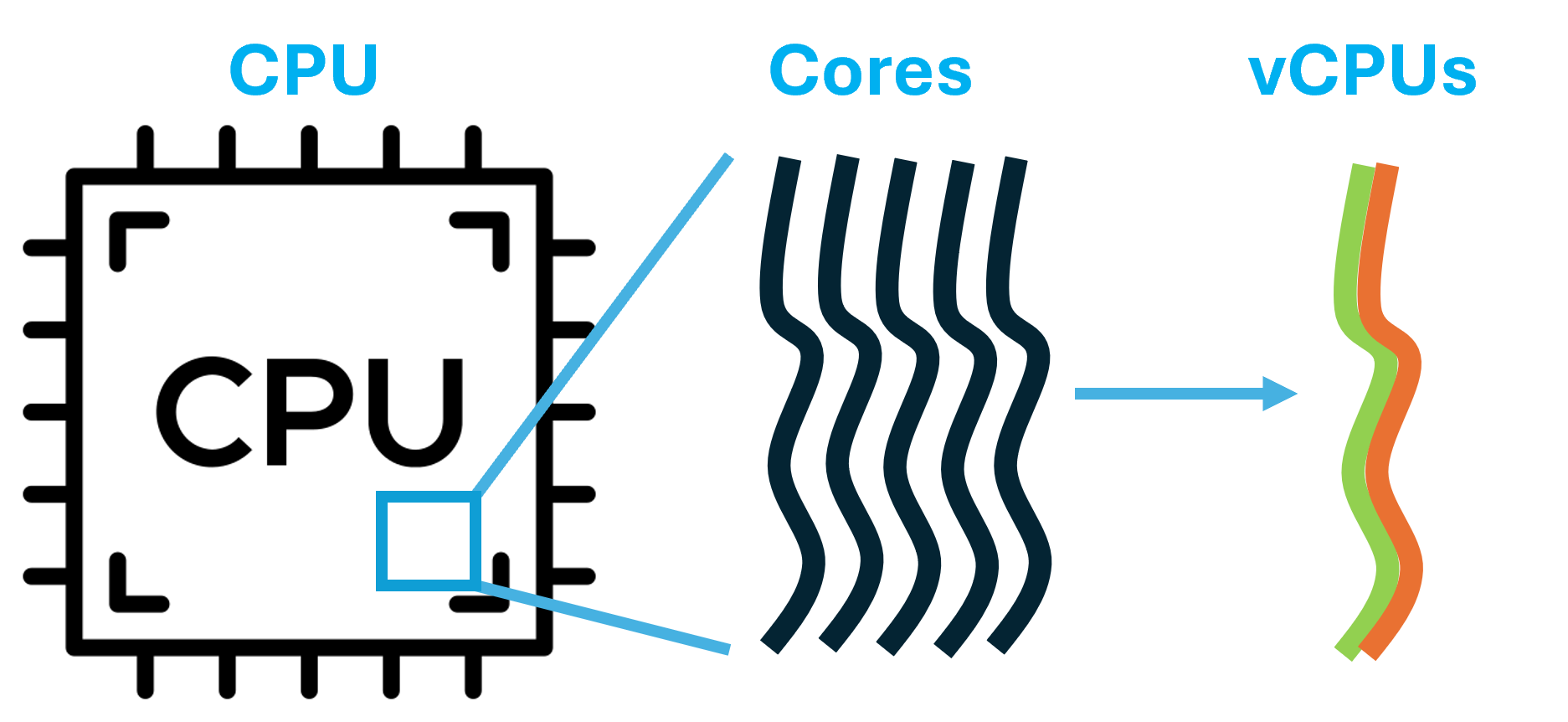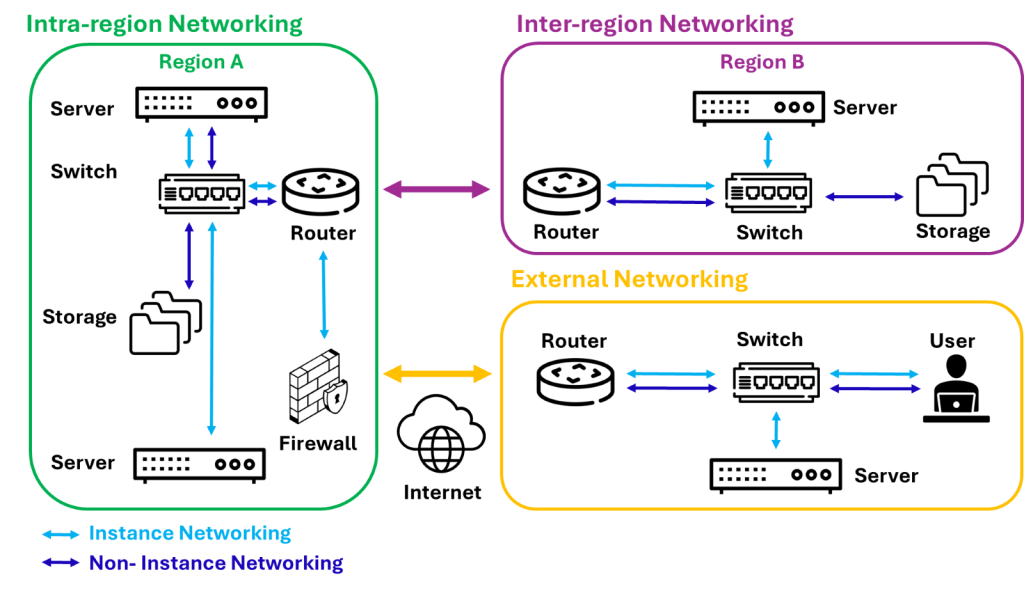Introduction
This summary outlines Tailpipe’s carbon emissions calculation methodology in brief. For a detailed explanation of each area of the Tailpipe methodology, including source documentation and worked examples, please review our Methodology.
Cloud computing releases emissions in two ways:
Operational Emissions – from the energy needed to power the cloud computing equipment within cloud service providers’ data centers.
Embodied Emissions – from mining, manufacture, transport and disposal of the hardware that provides cloud services.
These processes release a variety of different greenhouse gases. Tailpipe measures total emissions in kilograms of carbon dioxide equivalent (kgCO2e), which combines the impact of all seven greenhouse gases under the umbrella of ‘carbon emissions’.
Tailpipe’s methodology was developed in line with the international standard: ISO21031 for Software Carbon Intensity.
Formula Overview
Tailpipe calculates the kilograms of CO2e produced from an organization’s use of cloud computing using the following formula:
Total Emissions = Embodied Emissions + Operational Emissions
Embodied emissions are calculated as:
((Embodied Emissions of Components and Processes) * Disposal) * Time Share * Resource Share
Operational emissions are calculated as:
(Power Draw of Components and Processes in the Data Center + Power Draw of Networking outside the Data Center) * Carbon Intensity * Power Transmission Losses
Data Sources
Tailpipe gets its information about an organization’s cloud computing services and usage from their cloud service provider (CSP). CSPs publish many details of their cloud service specifications publicly, from which Tailpipe built the foundations of its cloud service database. This database was expanded upon with information from hardware manufacturers, research papers, and third-party organizations such as Boavizta and Ember.
For an organization’s specific usage information, Tailpipe uses their billing reports and utilization data. These are generated by CSPs for their customers, and detail customer usage in the form of CPU utilization, GB of data transferred, length of usage period, location of cloud service hardware, and total costs billable.
Embodied Emissions
In cloud computing, embodied emissions are released during the manufacture, shipping and disposal of the physical hardware that hosts cloud computing services. Tailpipe calculates the embodied emissions of an organization’s cloud computing by examining each component that is needed for the organization’s cloud computing to run.

vCPU Instance/Server
Cloud computing works by running workloads through servers. Servers are physical machines that contain hardware for processing and storing data. However, a single data center server usually has a much greater capacity than would be needed by a single customer. Therefore, cloud computing customers pay for virtual machines, or instances, which consume a certain proportion of the entire server’s resources.

Tailpipe first calculates the embodied emissions of the server hardware that hosts an organization’s virtual machine. Then, Tailpipe calculates the specific quantity of that machine’s emissions that the organization is responsible for by dividing the server emissions up according to the quantity of machine resources the organization has paid for and the time that the resource has been used for.
Embodied Impact Factors
To calculate the embodied emission of the server hardware, Tailpipe first multiplies the quantity of component in the server by its impact factor. These impact factors represent how much carbon is emitted in the manufacture of each component. They were calculated by the German Environment Agency in their 2021 study, Green Cloud Computing.
For example, a Central Processing Unit (CPU) contains 0.0197 kg of embodied CO2e per mm2 of CPU die size, plus 9.14 kg of embodied CO2e in the rest of the CPU material. So, Tailpipe finds the specific CPU contained within the server and multiplies these impact factors by the size of the CPU in mm2. A CPU with a die size of 694mm2 would be calculated as:
694 * 0.0197 + 9.14 = 22.81 kgCO2e
Tailpipe carries out the same calculation for each server component: CPU, RAM, storage (Solid State Drives (SSDs) or Hard Disk Drives (HDDs)), GPUs, the motherboard, the power supply units, and the enclosure. It also factors in external equipment and processes that are essential to the running of the server, such as network storage, networking equipment, and the assembly of the components.
Virtual Machine Hardware Embodied Emissions
Next, Tailpipe scales this server figure down, to apportion responsibility for emissions to the organization’s virtual machines. In most cases, this is done by dividing the number of virtual Central Processing Units (vCPUs) allocated to the organization, by the total number of threads in the server’s CPU. The server’s physical CPU is made up of multiple cores. Within cloud environments it is common for cloud providers to enable a technology called hyperthreading, which divides cores into two threads: sequences of instructions that the CPU can carry out. These sequences are purchased by cloud customers as vCPUs. Virtual machines – instances – take responsibility for a certain number of vCPUs from the server.

Taking our 694mm2 CPU above as an example, a virtual machine with 24 vCPUs, running on a server with 96 threads, would be calculated as:
22.81 * (24/96) = 5.7 kgCO2e
The same process of allocation is carried out for each component, and the total figures are added together.
Disposal
Tailpipe then factors in the impact of disposal on the overall embodied emissions of cloud computing hardware. Cloud service providers are becoming increasingly environmentally aware, and frequently recycle their hardware. This reduces the embodied emissions of cloud computing, because it reduces the need for raw material extraction and the manufacture of new hardware.
Tailpipe factors the final embodied emissions figure down by 1.8%, to take this recycling into account. This figure is based upon the 2019 Dell R740 Server Life Cycle Analysis.
Lifespan
The final factor to account for when calculating embodied emissions is the lifespan of the hardware, and the customer’s use as a percentage of that lifespan. Server hardware is in operation for six years, on average. Tailpipe therefore accounts for an organization’s usage as a proportion of the six-year lifespan (AWS Sustainability Report, 2023).
For example, consider an instance that is responsible for 50 kg of embodied CO2e. An organization that has been paying for the use of that instance for one year would be responsible for a sixth of those emissions:
50 * (1/6) = 8.33 kgCO2e
Operational Emissions
The operational emissions of cloud computing result from the energy generation process that provides the electricity that cloud service providers’ data centers need to power cloud computing services. Any task that a virtual machine carries out will require power, which is delivered to data centers on-demand from the local energy grid. Tailpipe therefore calculates how much power a virtual machine has drawn and multiplies this by how much carbon the local energy grid releases.

Components
Tailpipe begins calculating operational emissions by assessing the power draw of each hardware component. Just like with embodied emissions, Tailpipe calculates the emissions associated with the CPU, RAM, onboard storage (SSDs or HDDs), network storage, GPUs, motherboard, power supply units, and networking equipment.
| Component | Power draw (Wh) is based on: |
| CPU, RAM | CPU utilization |
| SSD, HDD, Network Storage | GB of data stored |
| Accelerators, motherboard, networking equipment | Average component power consumption |
Each component is fed power by a power supply unit (PSU). The PSUs used in data centers are very energy efficient, but 4% of power is still lost in the process. Every component power draw figure is therefore multiplied by a Power Supply Efficiency Factor of 1.04.
Each component has a specific calculation methodology, which is outlined in detail in Tailpipe’s Operational Emissions documentation.
Power Usage Effectiveness
Power Usage Effectiveness (PUE) is a measure of the energy efficiency of a data center, developed by The Green Grid. A PUE of 1 would imply that all power is used on the servers alone, with nothing wasted and no additional energy consumed for cooling and other ‘overheads’ that don’t directly power the cloud computing services, like office space.
Where data center specific PUEs are available, Tailpipe uses these actual values. Where they are not available, Tailpipe uses a figure of 1.22 (IDC, 2023).
Networking
Networking is the transfer of data between devices. Virtual machines require power to send and receive data on-demand. There are four types of networking associated with cloud computing:
- Intra-region networking: data transfer within one Cloud Service Provider (CSP) region, for example from Ireland to the UK.
- Inter-region networking: data transfer between two CSP regions, for example from Ireland to North America.
- External networking: data transfer via the Internet.
- Non-compute networking: data transfer that facilitates a customer’s use of cloud computing, for example transfer to, from and between storage.

Each of these types of networking draw different levels of power. This is because they take place on different networks, use different hardware, and are subject to different data center PUEs. Tailpipe accounts for each different type of networking using the following formulas:
| Intra-region Networking | (0.0006 * Intra-region GB of Data Transferred per hour) / 1000 |
| Inter-region Networking | (0.0006 * Inter-region GB of Data Transferred per hour) / 1000 |
| External Networking | (0.0058 * External GB of Data Transferred per hour) / 1000 |
| Intra-region Non-compute Networking | ((0.0006 * GB of Inter-region Non-instance Data Transferred per hour)/1000 |
| Inter-region Non-compute Networking | ((0.0006 * GB of Inter-region Non-instance Data Transferred per hour)/1000 |
| External Non-compute Networking | ((0.0058 * GB of External Non-instance Data Transferred per hour)/1000 |
Carbon Intensity
Adding together the individual component and process power draw figures gives the total power draw in Watt-hours for the entire utilization of the organization’s instances. Tailpipe converts this figure into kilograms of carbon dioxide equivalent (kgCO2e) by multiplying the power draw figure by the carbon intensity of the local grid.
Carbon intensity is a measure of how much carbon an energy source emits. Different energy sources release different levels of carbon – fossil fuels release the most, nuclear and biomass energy releases some, and solar, wind, and hydro-electric power release none. Different regions around the world have energy grids made up of different proportions of these energy sources, and so each region’s energy grid has a different carbon intensity.

Power Transmission Losses
Approximately 8% of energy is lost between the electricity generation source and the data center (Statista, 2024).
Tailpipe accounts for this loss by multiplying the carbon emissions figure by 1.08.
For example, in September 2024, Germany’s carbon intensity was 344 gCO2e/kWh. If an organization was utilizing an instance based in a data center in Germany, and that instance had drawn 1,000 kWh of power, the total operational emissions would be calculated as:
|
1000 * 344 * 1.08 |
= 371520 gCO2e |
|
|
= 371.52 kgCO2e |
Final Figure
Tailpipe then adds together the operational and embodied figures, to find the total carbon emissions of an organization’s use of cloud computing.
Using the operational and embodied examples above, this would be:
371.52 + 8.33 = 379.85 kgCO2e
Find Out More
For a detailed breakdown of each step of Tailpipe’s methodology, see the wider documentation. Detailed worked examples for operational and embodied emissions, using real datasets, are also provided. For an explanation of how Tailpipe can reduce an organization’s cloud spend and carbon emissions, see Tailpipe’s Recommendations.
To discuss what Tailpipe can do to measure and reduce your cloud computing spend and emissions, get in touch with us here.
Glossary
CO2e – Carbon Dioxide Equivalent (a measure that standardizes the impact of all seven greenhouse gases)
CPU – Central Processing Unit
CSP – Cloud Service Provider
GPU – Graphics Processing Unit
HDD – Hard Disk Drive
KWh – kilowatt-hour
PSU – Power Supply Unit
PUE – Power Usage Effectiveness
RAM – Random-access Memory
SSD – Solid State Drive
vCPU – virtual Central Processing Unit
Icons provided by Flaticon.




